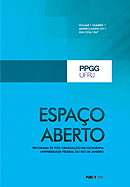A Methodological Proposal for Mapping Technogenic Relief in Areas of Environmental Disasters
DOI:
https://doi.org/10.36403/espacoaberto.2021.38470Keywords:
Anthropocene, Technogene, Environmental Disasters, Retrospective Geomorphology, BrumadinhoAbstract
When discussing the Anthropocene, human beings are considered to be important actors who due to their role as geological and geomorphological agents are responsible for both direct and indirect changes in landscapes. In this role, mining sites have recognized impacts on the construction and reconstruction of landforms by creating and inducing technogenic features. The present article treats the main landform transformations that occurred after the deposition of approximately 10 million m³ of tailings when a retention dam burst at the Córrego do Feijão Mining Complex, in Brumadinho (Minas Gerais State). Retrospective cartography based on geoprocessing, photointerpretation, and fieldwork is used to make a comparison between the morphology present before and after the dam failure. Even though the classification of technogenic terrains permitted the identification of different morphogenetic processes related to the Anthropocene, it was not enough for recognizing the geomorphologic consequences of the disaster, which points to the need for improving technogenic classes in order to better understand other similar disasters.


